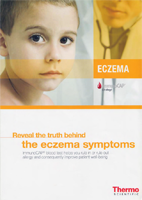Atopic eczema (atopic dermatitis) covers a wide range of skin complaints which may affect someone who is genetically predisposed (atopic).
The symptoms of atopic eczema vary according to the age of the sufferer. It often appears towards the age of 3 months; in 8 out of 10 cases, it appears before the age of 1 year. Atopic eczema normally lasts for several years. Fortunately, in 2 cases out of 3, it disappears of its own accord around the age of 6 years. Atopic eczema rarely lasts a whole lifetime.
Symptoms:
The principal symptoms are erythema (redness of skin) and a rash of pimples. The skin may also become greasy and form scabs.
The disease appears first of all on the child’s forehead and cheeks, spreading to the scalp and chin. Between the age of 3 months to 2 years, it makes the child lose sleep and causes agitation. However, his general state of health is not affected.
Up to the age of 2 years, atopic eczema is quite unpredictable. Flare-ups and remissions can happen at any time and may affect any part of the body.

A different phase may occur later, usually between 4-10 year old. In this phase, eczema frequently takes the form of a very itchy, pimply rash. The pimples are very often accompanied by peeling of the outer layers of skin, leaving scabs. The pimples and patches are found mainly in the folds of the body (bends of the knees, bends of the elbows, on the neck, etc.).
Besnier’s Prurigo is the form of eczema most common in adolescents and adults. Pruritus (itching) is persistent and may be very intense. This makes the sufferer strongly scratch, causing open wounds which may become infected.
Tip: Irritable?
People with prurigo are often extremely irritable and may even become aggressive towards people around them. This is understandable when you consider the agony of continuous itching
– If your child has atopic eczema, the best way to help is to be very gentle with him: be patient and show understanding.
– But don’t overdo it: be reasonably understanding but do not appear too worried: playing down is better than panicking.
Bathing and eczema
- Bathing does not need to be avoided, but do not stay in the water too long (prolonged contact with water irritates the skin).
- Take lukewarm baths (if the water is too hot the eczema may become worse).
- Do not use ordinary soap; there are special soaps for atopic eczema.
- You could also add bath oil to the water.
- After a bath or wash, coat the skin with a moisturising lotion.
Clothes and eczema
- Do not wear woollen clothing next to the skin (wool triggers itching).
- Cotton, long-sleeved underclothing is recommended.
- Avoid wearing rough or irritating fabrics such as polyester.
- Avoid tight or clinging clothing; sweat can cause irritation.
Leisure and eczema
- Choose a sport which does not make you sweat too much; sweat can lead to itching.
- Swimming pools with too much chlorine in the water may irritate the skin.
- Hydrotherapy can be beneficial.
- Relaxation, calm, and rest can help a lot.
- Avoid extreme weather conditions (extreme cold, extreme heat, long exposure to the sun, etc.).
Treatment for eczema is long-term and the hoped-for results will not come overnight. Response to treatment is very different from one person to another, so there is no use in making comparisons with “the neighbour down the street”! Keep trying and don’t change your doctor every few days!
Phototherapy (ultraviolet light treatment) is rarely beneficial as a treatment for atopic eczema.
Diet?
Many children suffering from eczema can continue eating normally. However, if the eczema is due to a food allergy (a strong possibility during the first 0-2 years of life), the offending food should be eliminated from the diet. Your doctor can help you identify the offending food.
Contact eczema
Contact eczema appears on the skin whenever it comes into contact with undesirable substances. A large number of products can cause this type of allergy. They can be classified into four main groups of allergens: medicinal, cosmetics, clothing, occupational.
- Medicinal allergens: ointments containing antibiotics (penicillin, chloramphenicol, etc.), pomades.
- Cosmetic allergens: toiletry products (soaps, shampoos, deodorants, etc.), perfumes, hair colourings, nail polish, “beauty products”, etc.
- Clothing allergens: detergents, fabric softeners, starch, dyes, accessories (buttons, hooks, buckles, etc.), leather, rubber, jewellery.
- Occupational allergens: cement, all products containing chrome (colourings, inks, paints, tanning products, etc.), glues, resins, exotic woods, etc.
Jeans-button allergy?
Seeing exactly where the contact eczema occurs makes it easier to find the culprit allergen. A typical example is eczema in the middle of a woman’s back, often due to the hook of her bra! Eczema near the navel may be so-called “jeans-button allergy”!
An allergy often plays hide-and-seek. You may think you are rid of it, then it suddenly reappears. You may think you are allergic to a certain fabric when, in fact, the culprit turns out to be the washing powder you use on it!
If you think you have contact eczema, it may be possible to carry out patch tests. These involve placing the suspected product against your skin and keeping it there for 2-3 days with a special bandage.

